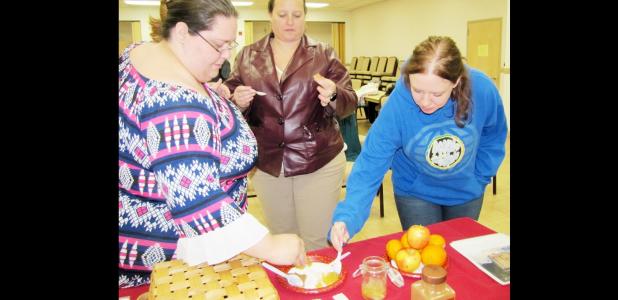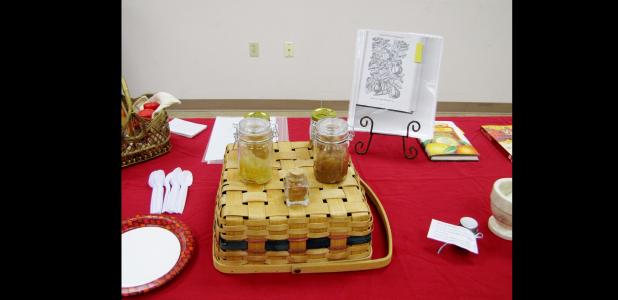SCA holds workshop on marmalade at library
Fri, 2017-01-27 05:00
News Staff
By PAMELA GRANT
Cove Leader-Press
When many people think about marmalade, they generally think about oranges. However, historically, marmalade was made with a variety of fruits, the most common being quince, which tastes like a cross between an apple and a pear.
A local medieval group known as the Society for Creative Anachronism (SCA) hosted a class at the Copperas Cove Public Library last Wednesday night. The class, taught by Taura Pool (known in the SCA as Taura McArthur-Blackwell), covered the history of marmalade and how it was made. At the conclusion of the class, participants were invited to taste quince marmalade, apple marmalade, and peach marmalade.
Pool taught the class that marmalade was made much earlier than people typically assume. A popular myth states that marmalade was first made in the 1700s after a ship carrying Seville oranges was stranded in the city of Dundee. The oranges were sold off cheaply to a local merchant whose wife turned it into marmalade. However, marmalade had already been around for hundreds of years. Mentions of marmalade made with quince are documented in ancient Roman and Greek history.
In medieval times, preservation of fruit was important. They typically used either honey or wine to preserve the fruit. Marmalade could be crafted from whatever types of fruits people could get a hold of. They were also really creative when it came to adding spices to the marmalade. Spices could include cinnamon, nutmeg, ginger, pepper, and more.
“You can basically make your marmalade taste however you want it to taste,” said Pool.
Honey which was used to preserve the fruit is a natural preservative and is also a natural antibacterial agent. In medieval times, marmalade was occasionally used as a medicine. Since they did not have pills back then, people would add whatever medicine a person might need, or want, to the marmalade.
After her class, Pool allowed participants to try batches of marmalade that she had made.
“They were all very good, but I liked the peach one best,” said Nathanial Cooper about the marmalade.
Cooper found out about the event from a flyer at the library. He said that he’s made jelly before and was interested in the idea of trying out about making marmalade. He said that he’d never even thought about making it with honey, and wasn’t sure if he’d try to make his own marmalade later on or not. He said that he would like to come to a future SCA event if he can find time for it.
Sherri Ruiz (known in the SCA as Melisenda de Barcelona) is a Laurel, Laurels are at the top level in the Arts and Sciences in the SCA. Pool is Ruiz’s apprentice in the SCA. Ruiz said that she thought Pool did an amazing job teaching the class. Both Ruiz and Pool are members of the Cook’s Guild of St. Martha, a group within the local SCA.
Ruiz has been in the SCA for many years. She met her husband, a Marine, at an SCA meeting, and said that the “cute Marine got me into the SCA”.
“What kept me there was the cooking, the study of the cooking, and cooks, and the food, and people saying that medieval food tastes horrible. They ask why does it taste horrible? Why would you think that? People say they would spice rotten meat so that you could eat it. LIES! That is NOT the reason. Things like that just pique my interest. I love doing this. I love researching it, studying it, sharing it, teaching it, all of it!” said Ruiz, speaking passionately about her love of the SCA and the Cook’s Guild.
“The most important thing [about the Cook’s Guild] is that even if you don’t cook, you can come and do things with the cook’s guild because not everything we do involves cooking,” said Pool. “We do research, we have made costumes so that the whole Cook’s Guild can match so that we can serve at events. The biggest fallacy is that you have to cook come. You don’t have to cook. You can even come just to listen.”
Those interested in the SCA or the Cook’s Guild are welcome to come to a future SCA group meeting. The group meets every third Wednesday of each month from 8 p.m. until 10 p.m. in the Copperas Cove Public Library’s meeting room. They also meet at 7 p.m. every Thursday at the Carl Levin Park in Harker Heights.
For more information about the SCA visit www.sca.org and for information about the Central Texas branch, visit hellsgate.ansteorra.org
To view more please log in or subscribe to the digital edition. http://www.etypeservices.com/Copperas%20Cove%20Leader-PressID141/


